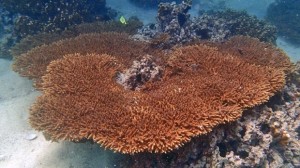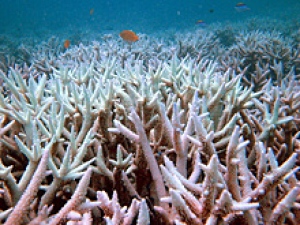http://mashable.com/2014/12/22/coral-bleaching/
By Andrew Freedman Dec 22, 2014
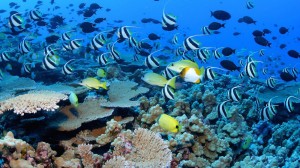
Colorful reef fish – Pennantfish, Pyramid and Milletseed butterflyfish – school in great numbers at Rapture Reef, French Frigate Shoals, Hawaii. Image: James Watt/Papahanaumokuakea Marine National Monument
In 1998, one of the most powerful El Niño events on record sent Pacific Ocean temperatures soaring to such heights that almost 20% of the world’s coral reefs experienced significant bleaching. Some of the reefs have never fully recovered from that episode.
Now, more than 16 years later, global warming appears to be doing what it used to require a super El Niño to do — push ocean temperatures so high across the Pacific Ocean that it sets off a major coral bleaching event, scientists warned Monday.
Coral reefs, vital marine ecosystems which are home to 25% of the world’s marine life and help provide food and livelihoods for millions of people, may be heading into one of the largest coral bleaching events on record, due to record warm ocean temperatures. This year is virtually guaranteed to set the record for the warmest year since instrumental records began in 1880, largely due to record high global ocean temperatures.
Corals are invertebrates that often grow in colonies in symbiosis with algae, known as zooxanthellae, which live in their tissues. It is these algae that give the corals their vibrant colors, and healthy coral reef ecosystems in turn provide food and shelter for a plethora of marine species. When ocean temperatures get too warm for too long a period of time, corals will expel the algae — giving them a sudden eviction notice. Once they do this, the corals turn a ghostly white color, which is where the term “bleaching” comes from.
Coral Bleaching Hawaii

Image: AP Photo/NOAA and the Hawaii Institute of Marine Biology, Courtney Couch
This 2014 photo provided by the National Oceanic and Atmospheric Administration and the Hawaii Institute of Marine Biology shows bleached coral at Lisianski Island in the Papahanaumokuakea Marine National Monument. The pale coral is bleached due to thermal stress, while the lavender-colored coral is healthy.
Studies show that coral reefs can survive individual bleaching events, but they are subject to higher mortality rates during such events, depending on the coral species and other factors. Climate studies show that warming ocean temperatures and acidifying oceans, due to the absorption of carbon dioxide from the atmosphere, pose major challenges for the viability of tropical coral reefs around the world.
Researchers monitoring the health of coral reefs around the world are sounding the alarm.
“As the ocean becomes more acidified the bleaching threshold for corals drops, more carbon dioxide makes corals more sensitive to thermal stress,” says Mark Eakin, coordinator of the National Oceanic and Atmospheric Administration’s (NOAA) Coral Reef Watch program, in an interview. “Not only are we seeing more thermal stress … but we’re making them more sensitive at the same time.”
Ocean Temperature Trends
Global average ocean surface temperatures for the January through November period from 1880 to 2014, showing 2014 as the warmest such period on record. The solid line is the long-term linear trend.
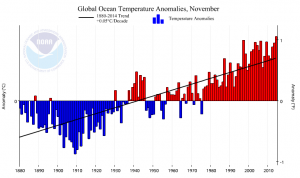
Image: NOAA
This year has been anything but average for ocean temperatures, particularly across the Pacific, where the worst coral bleaching events have been seen so far. Global average ocean temperatures were the warmest of any month on record in September.
Temperatures were so warm during that month that it broke the all-time record for the highest departure from average for any month since 1880, at 1.19 degrees Fahrenheit above average. August and June also set records for the warmest ocean temperatures on record, and the year is expected to set a similar milestone.
The fact that this warmth is occurring without a declared El Niño — though a weak event is predicted for this winter — strikes climate scientists as a clear sign that we’re now living in a new era with added heat in the climate system, making temperatures such as we’ve seen in 2014 easier to reach.
“We’re seeing a rising background temperatures, we’re seeing this increase in the thermal content of the oceans and as that happens it doesn’t take as nearly as big of an event to set off this chain of bleaching,” Eakin told Mashable.
Already in 2014, scientists say, widespread coral bleaching has occurred in Kiribati, Tuvalu, the Northern Mariana Islands, Guam, Hawaii and Florida. And computer models show widespread coral bleaching is likely throughout the tropics in the next several months, imperiling ecosystems from Madagascar to Australia.
“The bleaching event this year was fairly substantial,” said Steven Johnson and Lyza Johnston, who are biologists with the Commonwealth of the Northern Mariana Islands, which is a U.S. territory, in an email conversation. They said coral bleaching was widespread in the Northern Mariana Islands during the past year, and “mass mortality” was observed from a bleaching event in late summer and early fall between the islands of Pagan and Saipan.
Based on NOAA’s Coral Reef Watch products, Johnson and Johnston said in a joint response to inquiries from Mashable, “we expected we might see some bleaching in the northern islands this summer, but the extent and severity of the bleaching seen on Maug was unexpected.” (Maug is an island in the far north of the Commonwealth.)
With even warmer ocean temperatures predicted for the first part of 2015, the picture looks grim for corals that are especially sensitive to heat stress.
“We’re going to continue to see a pattern of high thermal stress that really follows the same sort of time sequence and movement of 1998 major event,”
“We’re going to continue to see a pattern of high thermal stress that really follows the same sort of time sequence and movement of 1998 major event,” says NOAA’s Eakin. “Everything we’re seeing says that same pattern is going to happen again this year.”
In the Mariana Islands, officials are looking warily at the latest climate outlooks. “We are very concerned about the possible impacts that an El Niño event in 2015 might have on the coral reefs of the Commonwealth of the Northern Mariana Islands, especially given the losses that have already occurred due to thermal stress over the last two years across the archipelago,” Johnson and Johnston said.
As of December, parts of every major ocean basin showed record high temperatures, according to NOAA’s National Climatic Data Center.
The latest NOAA Coral Reef Watch outlook shows bleaching alerts from Nauru through the Marshall Islands, Solomon Islands, Tuvalu, Fiji and Vanuatu, westward to near Papua New Guinea. Other alerts are in place along the eastern Australia coastline between Brisbane and Sydney, and in the southern Indian Ocean near the east coast of Madagascar. Other areas of concern include the southeastern South American coast, and parts of the South Atlantic Ocean between South America and Africa.
The Coral Reef Watch product is based on satellite-derived sea surface temperatures as well as scientific research about the susceptibility of different corals to thermal stress.
So far in 2014, rare and significant coral bleaching has taken place in Hawaii’s Papahanaumokuakea Marine National Monument, which is an area of about 140,000 square miles of protected oceans.
Coral Reef Watch
Coral Reef Watch bleaching outlook for the winter, showing areas with a 90% likelihood of seeing some degree of bleaching.
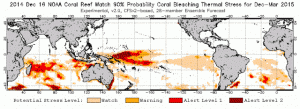
Image: NOAA
“We did have some very significant bleaching in some parts of the monument,” says NOAA fisheries ecologist Randy Kosaki, chief scientist for the National Monument. He said in some parts of Papahanaumokuakea, where waters are shallower, up to 90% of the corals have been damaged. Even coral species thought to be bleaching-resistant proved susceptible.
This was particularly the case in the vicinity of Lisianski Island, about 1,000 miles northwest of Honolulu.
Species such as the colorful Butterfly fish, which relies on corals for their food, have temporarily disappeared from bleached areas, Kosaki told Mashable. “They’re kind of the glamor fish of the coral reef world.”
This island, he says, demonstrates that the impacts from manmade climate change can reach even the most remote places on Earth. Scientists have not had a chance to survey the region via ship since September. But when they next reach the area, they are expecting to find “significant mortality” among the corals, Kosaki says.
Some bleaching was also noted near Kauai and Oahu, where waters tend to be cooler and bleaching is rarely seen, Kosaki said.
Because of the El Niño that was originally forecast to develop by early Fall, Eakin says scientists were expecting widespread coral bleaching events to take place in 2015. So the 2014 damage took coral watchers by surprise.
“We were concerned about bleaching that was going to be happening in 2015,” Eakin told Mashable. “We didn’t see 2014 coming.”
Now that he has seen it, plus the temperature outlooks, Eakin says, “I’m even more worried about 2015.”
h/t The Guardian
Special thanks to: Doug Fenner and the NOAA Coral-list
